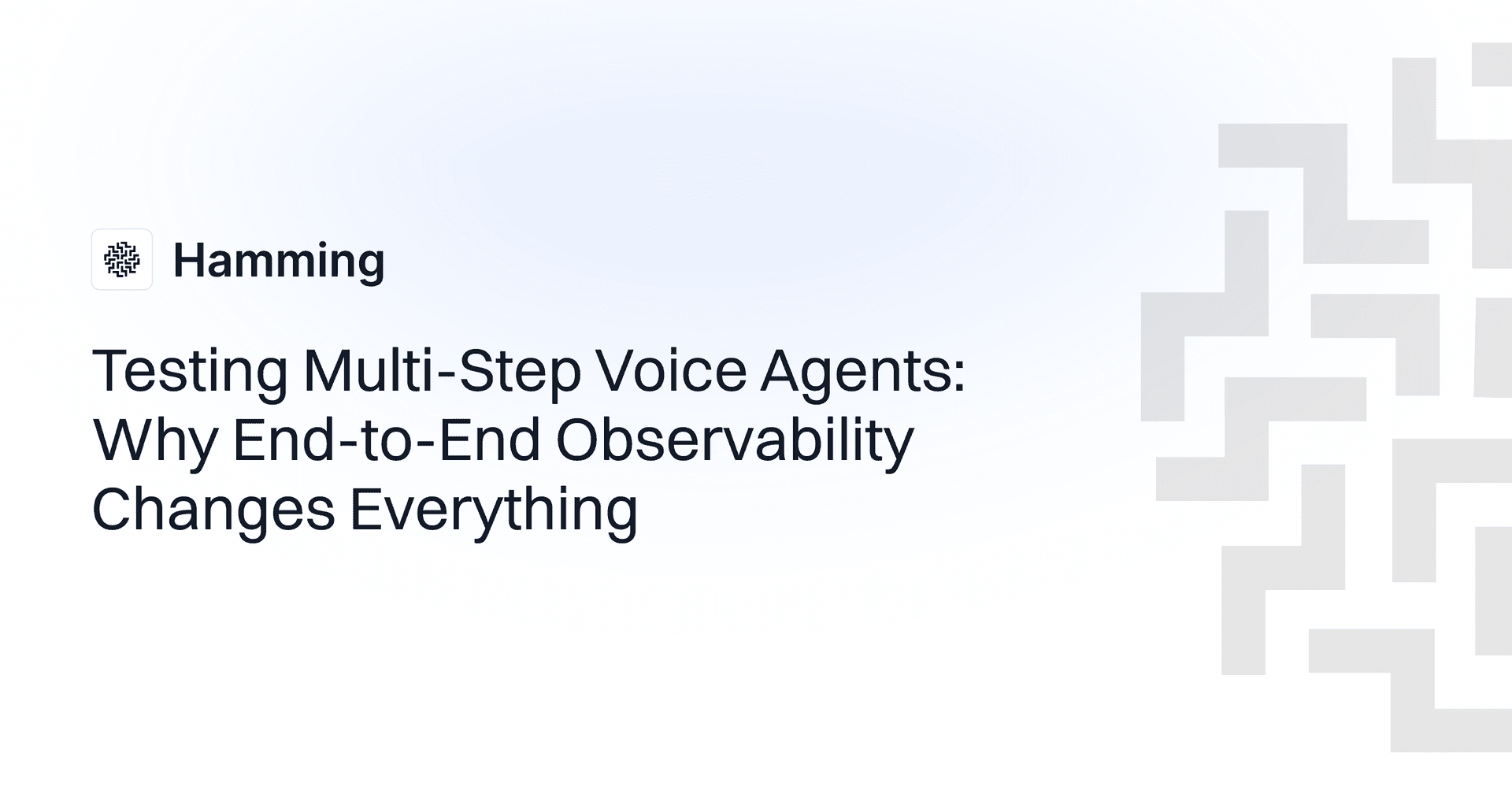Testing Multi-Step Voice Agents: Why End-to-End Observability Changes Everything
Single-turn voice agents are easy to test: if the intent was recognized and the right response was returned, it is considered a success. Multi-step voice agents are different. Take an appointment-booking scenario: a customer confirms a booking, immediately changes their mind, and asks to reschedule. The agent must verify identity, retrieve the original booking, check availability, update the calendar, send confirmations, and maintain context across six database calls and three APIs. By step four, it’s already asking for information the user has provided. By step six, context is gone.
That’s not a bug in the code. It’s what happens when multi-step workflows run in production without proper observability.
Every added step multiplies the risk of failure. Context degrades. Latency compounds. Dependencies cascade. Standard testing tools can’t show you where conversations actually break. End-to-end voice observability does. It tracks the full pipeline, from ASR to API calls to final response, so it is easy to identify where breakdowns occur and fix them before customers are affected.
Quick filter: If a workflow has 4+ steps and touches a database or payment system, test it end‑to‑end or expect surprise failures in production.
Here's how to implement comprehensive testing that tracks every stage from ASR to final output—ensuring voice agents handle complex, multi-turn conversations as reliably as simple requests.
| Workflow stage | Typical failure | What to monitor |
|---|---|---|
| ASR and intent | Misheard entities | Confidence drop, re-prompts |
| State handoff | Lost context | Missing slot values across turns |
| Tool calls | Latency or timeouts | API errors and retries |
| Response generation | Off-path replies | Assertion failures |
| End-to-end flow | Partial completion | Workflow-level success rate |
Related: For systematic intent testing methodology, including out-of-scope detection and first-turn accuracy metrics, see Intent Recognition for Voice Agents: Testing at Scale.
The Hidden Complexity of Multi-Step Voice Workflows
Voice agent conversations follow this pipeline: Audio Capture → ASR → Intent Recognition → Dialog Management → Action/Retrieval → Response Generation → TTS. Each component appears straightforward in isolation, but in production, systems face steeper challenges:
- ASR accuracy, which is normally 85-95% per turn varies with audio quality, accents and background noise
- Intent recognition, which is typically 90-95%, becomes less reliable as conversations grow longer and more dynamic, especially when customers backtrack, change their mind, or pile multiple requests into a single turn, intents blur and classification degrades.
- Target latency is typically 1000ms end-to-end per interaction, this compounds with every extra API call or database lookup. By the time a workflow touches multiple tools in sequence, response times creep upward and natural conversation breaks down.
Consider a return request workflow:
- Verify identity → Query user database, validate credentials
- Check order history → Retrieve purchase records, confirm item details
- Validate return policy → Check eligibility, calculate deadlines
- Process return → Generate RMA, update order status
- Update inventory → Adjust stock levels, trigger restocking
- Send confirmation → Email receipt, update CRM
Each step depends on previous success. The agent must maintain user identity, specific order, and return reason throughout. Lose the order reference from three turns ago? Start over.
Latency accumulates: 200ms ASR delay becomes 400ms after intent recognition, 800ms after database lookups. Step six pushes against patience limits.
Why Component Testing Falls Apart for Multi-Step Agents
Critical failures happen between components, not within them. A slightly delayed ASR output shifts token timing, which confuses intent recognition. A misclassified intent leads dialog management down the wrong path, an extra database call pushes latency past the threshold for natural conversation.
State handoffs corrupt data subtly. ASR correctly transcribes "order number 12345" but intent recognizer tokenizes it as "order number one two three four five." Both components work correctly by their specifications. The workflow fails.
Context degrades gradually. Turn one captures the user's name. Turn three maintains it. By turn five, after two tool calls and context window rotation, it's gone. No component failed—the system couldn't maintain state.
Timing issues emerge only in multi-step flows. Component A passes control to Component B, which isn't ready because Component C still processes a previous request. Each handles load perfectly in isolation. Together, they deadlock.
How Single Failures Collapse Workflows
Cascade analysis reveals failure propagation through multi-step workflows. One incorrect entity extraction doesn't affect just one response,it corrupts every dependent step.
Mishear a product name in step one? Query wrong inventory in step two. Retrieve incorrect pricing in step three. Process wrong order in step four. Each step executes perfectly based on flawed input.
Recovery requires observability. For instance, if users complain about wrong products, the agents check order processing, which appears correct. The actual error happened four steps earlier in ASR. Without end-to-end tracing, you'll never find it.
We’ve seen this exact pattern in return flows: the final confirmation looked fine, but the product ID was wrong from step one.
Proximal errors manifest as distal failures. Memory leaks in state management don't cause immediate problems. Three conversations later, when context windows fill, agents hallucinate previous users' information. Symptoms appear nowhere near causes.
Building End-to-End Observability for Voice Workflows
Voice agent observability extends beyond standard Metrics, Logs, and Traces. Voice workflows require five additional pillars designed for conversational AI.
Workflow Completion Tracking
Success metrics must span entire conversation flows, not individual steps. Six of seven completed steps equals total failure from user perspective.
Implement checkpoints at major workflow transitions. Track whether each step executed and whether it produced expected state for the next step. Database queries returning empty results technically succeed but break workflows when next steps expect data.
Create workflow-level success criteria reflecting actual user goals:
- "Appointment rescheduled" = all six steps complete correctly
- In order
- Within latency budget
- With accurate data propagation
State Persistence Monitoring
Track every state element: user identity, conversation history, pending actions, partial responses. Monitor how components access and modify shared state.
Implement integrity checks between steps. Before "updating your order," verify the correct order ID from three turns ago persists. Hash critical variables and compare across transitions.
Monitor memory usage and context window management continuously:
- Context consumption per turn
- Rotation timing
- Information loss patterns
Most context loss happens silently—agents continue responding with degraded accuracy.
Instruction retention matters in longer conversations. Agents must remember data plus behavioral instructions: "speak slowly for this user," "use formal address," "already transferred once."
Action Dependency Validation
Map every tool call sequence and dependency. Refunding orders requires:
- Verify order exists
- Check refund eligibility
- Calculate amount
- Process payment reversal
- Update inventory
Validate input/output contracts between steps rigorously. Order lookups return order objects. Refund processors expect specific fields. When contracts break—field names change—workflows fail mysteriously.
Distinguish recoverable from fatal errors:
- Inventory update timeout: retryable
- Missing required order field: abort workflow
Concurrent operations introduce race conditions. Processing refunds while checking inventory succeeds individually but inventory checks use stale data. Proper dependency validation prevents conflicts.
Error Recovery Mechanisms
Design degradation patterns for common failures:
- Payment API timeout? Collect information, process asynchronously
- ASR confidence below threshold? Request repetition or transfer
Step-level retry logic must preserve context. Repeating failed API calls isn't enough, maintain conversation state, remember user input, adjust responses accordingly.
Create fallback workflows:
- Database unavailable → Switch to cache
- Primary LLM overloaded → Route to backup model
- Each fallback maintains conversation continuity
Build guardrails against hallucinations and prompt injection. When context corrupts, agents fabricate information or execute unintended actions. Validate generated content against source data. Sanitize user input before prompt construction.
User Experience Metrics
Measure latency distribution, not averages. P95 latency reveals worst-case user experience. 500ms average means nothing if 5% wait 3 seconds.
Track conversation flow smoothness through turn transition timing. Optimal response: 200-400ms after users finish speaking.
Monitor frustration signals actively:
- Repetitions → ASR failures
- Corrections → Intent recognition problems
- Abandonments → Complete workflow breakdown
Each signal points to specific failure modes.
Turn detection optimization directly impacts experience. Too aggressive: constant interruptions. Too conservative: sluggish conversations. Track interruption rate and response delay to find balance.
Implementing Production-Grade Testing for Multi-Step Agents
The testing pyramid for voice workflows: Unit → Integration → End-to-End → Chaos. Each level validates different failure modes.
- Unit tests: Individual component verification
- Integration tests: Component interaction validation
- End-to-end tests: Complete workflow verification
- Chaos testing: Real-world failures (network latency, API timeouts, noisy audio, concurrent requests)
Scenario-based testing must cover multi-turn conversations:
- State persistence: "User provides information in turn 1, agent recalls in turn 5"
- Context overflow: "20-turn conversation maintains data integrity"
Synthetic monitoring provides continuous validation. Hamming's synthetic testing approach simulates complete user journeys. Voice Characters call agents, navigate multi-step workflows, validate responses at each turn.
Implementation checklist:
- Test data preparation: Multi-turn scenarios with realistic conversation flows
- State injection: Start tests mid-conversation, validate recovery and context handling
- Latency budget allocation: Total response under 1 second
- Error injection: Test recovery from ASR failures, API timeouts, state corruption
- Concurrency testing: Validate behavior under simultaneous conversations
Optimizing Latency Across Multi-Step Workflows
Latency budget allocation requires strategic decisions:
- ASR: 200ms
- Intent recognition: 100ms
- LLM inference: 300ms
- Tool calls: 200ms
- TTS: 200ms
- Total: 1000ms
Multi-step workflows need flexibility, slower steps compensated by faster ones.
Parallel and streaming architectures reduce perceived latency:
- Start TTS during LLM generation
- Prefetch likely next data during current processing
- Stream audio as produced, not after complete generation
Edge processing eliminates network round trips:
- Deploy VAD at edge for immediate speech detection
- Cache frequently accessed data locally
- Process simple intents without cloud calls
Model optimization trades accuracy for speed where appropriate:
- Quantize models for faster inference
- Prune unnecessary parameters
- Use smaller models for simple tasks, reserve large models for complex reasoning
Asynchronous workflow orchestration prevents blocking. Process next audio chunk while waiting for database results. Prepare TTS pipeline during LLM inference. Every saved millisecond compounds across multi-step flows.
Why Specialized Tools Matter
General-purpose observability tools miss voice-specific requirements. They can't correlate audio with transcripts, track conversation state across turns, or validate tool call sequences. Voice agents need purpose-built observability.
Audio correlation requires understanding speech patterns, not bytes. Transcript alignment needs semantic understanding, not string matching. Prompt tracking must capture context evolution across turns.
Hamming provides native voice workflow observability:
- Automated evaluations: Thousands of synthetic calls testing every workflow path
- Real interaction conversion: Production conversations become test cases
- Scenario-level metrics: Success rates for complete user journeys, not individual turns
- Automatic tagging: Identifies and categorizes failure patterns across conversations
The debugging difference becomes clear. Without proper tooling: hours correlating logs, manually replaying conversations, guessing at state corruption. With Hamming: click failed conversation, see complete trace, identify exact failure point, understand cascade pattern.
Testing Multistep Agents with Hamming
The shift from component testing to workflow observability changes everything. Prevent failures instead of debugging them. See exactly why conversations break instead of guessing.
Explore Hamming to implement comprehensive observability for voice workflows. Or dive into the technical docs to start building observable multi-step agents today.

